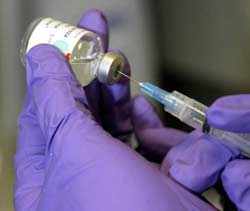Many pregnant women want to prevent congenital rubella in their children through vaccination. However, Dr. Pham Ngoc Dinh, Deputy Director of the Central Institute of Hygiene and Epidemiology, warns that this should not be done as it can be dangerous.
 |
| Pregnant women should not be vaccinated against Rubella (Photo: abc.net) |
Dr. Pham Ngoc Dinh advises that if a mother wants to protect her fetus from rubella, she should receive the vaccine at least one month before conception, ideally 3-4 months in advance. Once pregnant, it is absolutely prohibited to receive this vaccine as it contains a live attenuated virus, which is typically produced in combination with vaccines for measles and mumps.
Once pregnant, the best way to prevent rubella is to limit contact with crowds, especially during outbreaks; wearing a mask when going outside. Regularly maintain oral and respiratory hygiene with gargling solutions. Pregnant women should also monitor and be alert for symptoms of febrile infectious rash.
Dr. Dinh also addresses some common questions about rubella:
– At what age is rubella most common?
– Rubella can affect individuals of any age but is most commonly seen in children. However, there has been a recent increase in cases among adults.
– When does the disease most commonly occur?
Among more than 10,000 cases reported last year, nearly 60% occurred between March and July. In the southern region, the disease is present year-round. In the northern region, rubella is more prevalent during the winter and spring, but this year, there has been an increase in cases towards the end of spring and the beginning of summer. Specifically, the last three months have seen a continuous rise in cases, with over 1,000 reported in April alone.
– Is rubella a benign or malignant disease?
– It can be both. It is generally benign for children and adults. If well cared for, the illness resolves without complications. The complication rate for rubella is significantly lower than that of measles (1% compared to 10%). Possible complications include thrombocytopenic purpura, encephalitis, nephritis, orchitis, and arthritis.
However, for pregnant women, rubella is an extremely serious illness as it can easily lead to stillbirth, miscarriage, or congenital rubella syndrome in the child (with an 85% risk if the mother contracts the disease in the first trimester). Children affected by this syndrome often experience developmental delays and physical disabilities, congenital heart defects, blindness, deafness, and issues with the liver, spleen, and bone marrow.
– Can someone who has recovered from rubella still transmit the virus?
– The virus that causes rubella can persist in patients for an extended period. More than 80% of children with congenital rubella syndrome may shed the virus through respiratory secretions and urine for several months after birth.
Rubella falls within the group of diseases with the highest transmission rates. Over 80% of unvaccinated individuals can contract rubella if exposed to an infected person. This is why rubella can easily lead to outbreaks in large groups. In 2005, 65% of reported outbreaks occurred in schools or industrial zones.
– What are the signs of rubella?
– Rubella should be considered when there are four symptoms: fever; a maculopapular rash (the rash forms patches); swollen lymph nodes in the neck, behind the ears, and at the nape; and muscle and joint pain.


















































